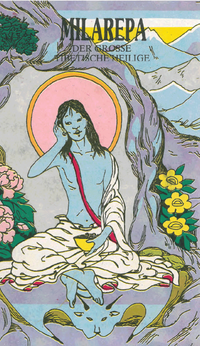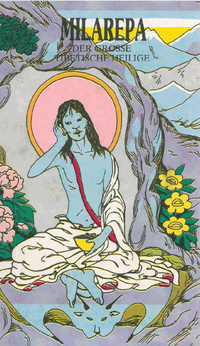Vielfalt der Religionen
Mai 2024
Am 06. Mai 2024 fand im Münchner Rathaus eine Veranstaltung mit verschiedenen religiösen Gruppen statt. Es sollte damit die Vielfalt religiösen Lebens in unserer Stadt gezeigt werden. Ziel war, die einzelnen Gruppen vorzustellen. Jeder Gruppe stand ein kleiner Tisch zur Verfügung für Infomaterial, und das Rathaus hatte zusätzlich für jeden Verein ein Poster fertiggestellt.
Im Anschluss des Programms konnten wir mit den Mitarbeitern der Stadt und natürlich auch mit allen Glaubensvertretern sprechen. Auch die verschiedenen Anlaufstellen für die Gruppen wurden in zwei Referaten von Herrn Sarnowski und Herrn Tuan Tran vorgestellt. Das war sehr hilfreich!
Insgesamt konnte so ein Bewusstsein über die Vielfalt der Gruppen erzeugt werden.
Sven Frehse und Christiane Zeunert
Biographie des Ehrw. Lama Je Tsongkhapa
Je Tsongkhapa war ein großer tibetischer buddhistischer Meister im 14. Jh. Das Wirken Je Tsongkhapas für die buddhistische Lehre allgemein und besonders für die Lehrtradition in Tibet war unermesslich. Durch seine disziplinierte Lebensführung war er ein großes Vorbild nicht nur für seine Schüler und seine Gelehrtheit war unter den Gelehrten unumstritten.
Hier klicken und mehr erfahren
Milarepa: Tibets großer Yogi
Milarepas außergewöhnlich spannende Lebensgeschichte wurde vor einiger Zeit vom "Council for Tibetan Education" in einer Comic-Version veröffentlicht und kann bei uns heruntergeladen werden.
BÜCHERTIPP - TIBETS ERLOSCHENER GLANZ
Hier klicken und mehr erfahren
DIE NAGAS
Wissenswertes über sie in Kürze
Naga m, Nagini f (Sanskrit) bedeutet Schlange. In der indischen Mythologie bezeichnet es Schlangenwesen oder Schlangengottheiten. Die Darstellungen variieren: entweder vollständig als Schlange oder mit menschlichem Oberkörper, aber Unterkörper ist schlangengleich. Sie können auch mehrere Schlangenköpfe haben, so wie in der Darstellung des Buddha Shakyamuni, der vom Nagakönig Mucalinda mit seinen sieben kobraartigen Köpfen in seiner Meditation beschützt wurde (wie auf dem Foto oben).
Von Nagarjuna wird gesagt, dass er die Prajnaparamita-Sutras von den Nagas erhielt, die sie aufbewahrt hatten. Auch er wird mit Nagaköpfen hinter seinem Kopf dargestellt.
Nagas zählen zum Tierbereich, haben jedoch übernatürliche Fähigkeiten. So können sie zum Beispiel als Menschen auftreten und sich unter uns aufhalten.
Ihr tibetischer Name ist Lu (klu). Im größten tibetischen See, dem Manasarowar-See lebt einer der 8 Nagakönige, der – wie alle Nagas – besonders mit der Natur verbunden ist.
Der Nagakönig vom Manasarowar-See ist ein Bodhisattva-Naga und eine Quelle für das Wohlbefinden unserer Natur, unseres Klimas, der Ernten, überhaupt des Wohles unseres Planeten.
Es gibt Nagas, die uns helfen wollen und auch helfen, aber wir bemerken das nicht. Es ist für sie schwer zu ertragen, dass wir ihren Lebensraum verunreinigen, was unserem verunreinigten Geist entspricht. Wir nehmen ihre Hilfe nicht wahr, was für sie Undankbarkeit bedeutet. Durch das Weggehen der Nagas nehmen die negativen Kräfte überhand. Wenn sie wegen der Verunreinigung ihres Lebensraumes ihre Wohnstätten verlassen, hat dies gravierende Folgen für uns wie z. B. Naturkatastrophen.
Nach tibetischer Vorstellung wohnen Nagas vor allem in Flüssen und Seen. Sie sind leicht aufgebracht und es heißt, dass sie einen 9 Leben lang verfolgen, wenn man sie gereizt hat. Verschmutzen wir weiter ihre Wohnstätten, schicken sie Krankheiten wie Hautkrankheiten, Lepra und auch Aids zählen dazu.
Durch Rituale und Opfergaben kann man sie besänftigen. Man führt Rauchopfergaben durch (Lusang), opfert ihnen Wasser oder man bringt Milch und kleine Tormas dar (wie beim Lutor und Torma gyatsa Ritual s. Foto), in die man die 3 süßen (Honig, Zucker und Melasse) und die 3 weißen Substanzen (Milch, Joghurt und Butter) mischt. Tücher in den Farben der 5 Elemente mögen sie gerne und man benutzt sie während des Rituals. Auch ein Mantra gibt es für sie.
Die Rituale führt man nur an bestimmten Tagen durch; an anderen Tagen ist es nicht ratsam, denn man weckt die Nagas auf und sie werden zornig. Durch die Rituale versucht man, den Lebensraum der Nagas zu heilen.
Maria Anna Kneisl
Quellen:
Wikipedia und aus Belehrungen von Ven. Panglung Rinpoche und Ven. Gonsar Rinpoche
Lifestory of venerable Lama Je Tsongkhapa
Je Tsongkhapa was a great Tibetan Buddhist master in the 14th century. Je Tsongkhapa's impact on Buddhist teaching in general and especially on the teaching tradition in Tibet was immeasurable. Through his disciplined way of life, he was a great role model not only for his disciples and his scholarship was undisputed among scholars.
Click here for more informations
MILAREPA - THE GREAT YOGI OF TIBET
Almost every Tibetan knows the great Yogi Milarepa. He lived in the 11th century in the Northwest of Tibet and came from a wealthy family. He is not only seen as one of Tibet’s foremost yogis and ascetics but also as one of the most renowned Tibetan poets. He is an inspiring example for someone who has been able to accomplish full enlightenment based on his own personal efforts, diligence, and trust in his Master.
Milarepa's intriguing life-story has been published some time ago by the Council for Tibetan Education in a comic-like version. (Editor: Lobsang T. Rikha, illustration: Elisabeth Brombill, German translation: Pasang Dahortsang and Marianna Kneisl). Those of you who understand German can download it here.
Summary
When Milarepa was seven years, old his father died. Before his death, the father had appointed Milarepa’s uncle and aunt as manager of his possessions until Milarepa would be old enough.
But uncle and aunt driven by greed treated Milarepa and his mother as servants, who had to work very hard.
Milarepa’s mother, overwhelmed by hate, commanded her son to study black magic. Milarepa followed her instructions obediently and soon mastered this „art“ very successfully: He managed to destroy the family of uncle and aunt including their house and the complete farm.
At a later time, Milarepa regretted his crimes with all his heart. He finally found his Master, Marpa Lotsawa. But before Marpa accepted him as his student, Milarepa had to undergo multiple hard and challenging tests. Milarepa meditated for many years and finally became a realized Yogi.
When the time had come for him to die, he drank - with full knowledge of the consequences - a poisoned yogurt, that a scholar, who was jealous of his fame, had given to him.
THE KALMYKIANS AND THEIR TEMPLE IN MUNICH-LUDWIGSFELD
The small temple, located in an apartment building, is the oldest one in Munich. For many years it was the only Buddhist temple following the Tibetan tradition in Germany.
THE NAGAS
(brief information)
Naga (m), Nagini (f) means snake. In Indian mythology it describes serpent beings or serpent deities. The representations vary: either completely as a serpent or with human upper bodies but the lower body is like a snake. They can also have several snake heads as in the representation of Buddha Shakyamuni where he has been protected in his meditation by the naga king Mucalinda with his 7 cober-like heads (as shown in the image above).
It is said that Nagarjuna received the Prajnaparamita-Sutras from the Nagas, which they had stored. He too is depicted with Naga-heads behind his head.
Nagas belong to the animals realm but they have supernatural abilities. They can, for example, appear as human and stay among us.
Their Tibetan name is Lu (kLu). In the largest Tibetan Lake, the Manasarowar lake, lives one oft he 8 Naga kings, who – like all Nagas – is particularly connected with nature.
This Naga-king is a Bodhisattva-Naga and a source for the well-being of our nature, of our climate, of the harvests and of the well-being of our planet in general.
There are Nagas who want to help us and also do, but we don’t notice it. It’s hard for them to bear that we pollute their habitat, which corresponds to our polluted mind. We do not recognize their help, which they understand as ingratitude. If Nagas move away, the negative forces will increase. If they leave their homes because of the pollution of their habitat, this has serious consequenses for us, such as natural desasters.
According to Tibetan conception, Nagas live mainly in rivers and lakes. They get quickly upset, and they say they will follow you for nine lifetimes if you have made them angry. If we continue to pollute their homes, they will send deseases like skin diseases, leprosy and also Aids.
Rituals and offerings can calm the Nagas. One can offer a smokeoffering, offer them water or milk and Tormas. In the Torma dough the 3 white and the 3 sweet substances are added (milk, yogurt, butter and honey, sugar and molasses).As they like cloth in the colors of the 5 elements these used during the ritual. There is also a Mantra for them.
The rituals are only performed on certain days. On other days it is not recommended, because you wake up the nagas and they get angry. Through the rituals one tries to heal the habitat of the Nagas.
Maria Anna Kneisl
Sources: Teachings from Ven. Panglung Rinpoche and Ven. Gonsar Rinpoche and Wikipedia
.jpg/picture-200?_=19017a143b8)
.jpg/picture-200?_=19017a13be8)






